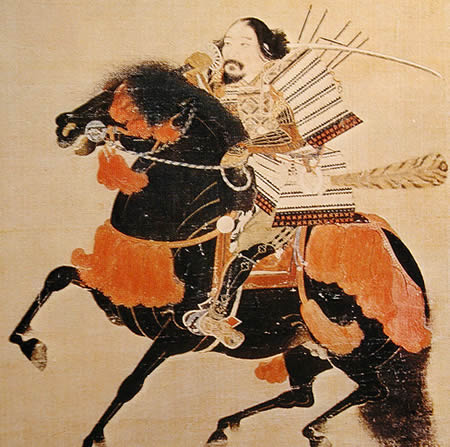 |
| Emperor Go-Daigo |
In 1185 the young Japanese emperor Antoku, some seven or eight years old, was drowned in the Battle of Dannoura in the Inland Sea by his grandmother, rather than be captured by their enemies. The power of the Taira clan, with which he was allied, was destroyed, and the victors were the Minamoto clan. Their leader, Minamoto Yoritomo, saw the death of the emperor as an opportunity to establish the first shogunate, or military government, in Japan.
Although the Minamotos would still pay lip service to the institution of the emperor, which was considered divinely inspired by the Japanese, there was no doubt that Yoritomo was the real ruler of Japan. Prudently Yoritomo enlisted the support of the retired emperor, Go-Shirakawa, to give his blessing to the new regime that has been called the Bakufu, or tent government, because the samurai, the military class, controlled the country.
When Yoritomo died in 1199 his widow, Masako, having two weak sons, was able to transfer the power of the shogunate to her own clan, the Hojos. The Hojo clan proved capable military rulers and in 1274 and 1281 fought back the Mongol invasions of Kubilai Khan from China.
 |
In 1281 the second invasion fleet (lacking a maritime tradition, the Mongols had to rely on Koreans for their navy) was destroyed by an immense typhoon that entered Japanese history as the kami-kaze, or “divine wind,” which saved Japan. In struggles fought within Japan, like the war between the Taira and the Minamoto, there had always been the wealth of the vanquished to be dispersed among the followers of the victors. However because both Mongol operations were amphibious landings, there was no real booty to be disposed of among the victorious samurai.
The discontent among the samurai, and their daimyo, or lords, grew over time. With the growing antagonism of the samurai warrior class, the bonds of loyalty to the shogunate and its tent government began to loosen. In 1318 a new emperor, Go-Daigo, ascended the throne. A fully grown man, unlike the hapless Antoku, Go-Daigo was determined to be emperor. Luckily for him, the Hojo shogun at the time was more in favor of pleasure than power, and the new emperor was able to quietly make his plans.
As Turnbull remarks in The Book of the Samurai: The Warrior Class of Japan, “by the 1330s resentment against the Hojo began to come into the open ... and the unifying force proved to be, of all things, the emperor, in an anachronistic attempt to restore the long-lost prestige of the throne.”
In a bid for control, the retired emperor Go-Uda helped Go-Daigo. In 1331 Go-Daigo attempted an uprising against the Hojos, but he was taken prisoner by the Hojos. He was exiled but managed to escape, most likely with the help of followers in the Hojo camp. Within a year, in 1332, Go-Daigo was ready to make another attempt.
 |
| Ashikaga Takauji |
The Minamoto triumph in 1185 had set a dangerous precedent in Japan. Any feudal daimyo could ascend to the shogunate, if he proved he had enough military force and could secure the support of the emperor. The Hojos sent their best commander, an ambitious daimyo named Ashikaga Takauji, to Kyoto to try to make Go-Daigo cower before a show of force.
But following in the footsteps of the Minamotos and the Tojos, Ashikaga Takauji now proclaimed himself the defender of Emperor Go-Daigo. Ashikaga Takauji, with the help of Nitta Yoshisada, was able to attack the seat of the Hojos at Kamakura and topple their Bakufu.
The era that followed is known as the Kemmu Restoration. Once the Hojo power was broken, Ashikaga Takauji revealed that supporting Go-Daigo was only a means to an end. Rather than restoring the emperor to his rule, Ashikaga Takauji had only coveted the shogunate for himself. The era that has become known as the Ashikaga Shogunate opened in Japan.
   |
However Go-Daigo, the 96th emperor of Japan, had no intention of sharing power with Ashikaga Takauji. As a result Ashikaga drove Go-Daigo out of the imperial city and found a more pliant member of the imperial family who dutifully appointed him as the shogun. Rather than surrender Go-Daigo fled into the mountains of Yoshino south of Kyoto, determined to continue the fight.
The period that ensued was known as the Nambokucho War and would last for 60 years, the longest single war in Japanese history. While some daimyo and their samurai followed Ashikaga, others remained loyalists to Go-Daigo. Among these was Kusunoki Masashige, who died fighting for Go-Daigo in the Battle of Minatogawa in 1333.
Although there were two imperial courts, the northern one with Ashikaga Takauji in Kyoto and the southern under Go-Daigo in the mountains, after 1337, Ashikaga Takauji was really in control of Japan. In 1392 the southern court returned to Kyoto, and the period of two imperial capitals ended. Ashikaga Takauji established his own shogunate, which would rule for less than a century.